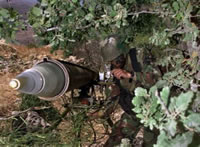Assessment of the Second Lebanon War By Col. David Eshel
 Realizing the capabilities of the Merkava 4 tank, Hezbollah allocated their most advanced weaponry to combat this advanced tank, engaging these tanks exclusively with the heavier, more capable missiles such as 9M133 AT-14 Kornet, 9M131 Metis M and RPG-29.
Realizing the capabilities of the Merkava 4 tank, Hezbollah allocated their most advanced weaponry to combat this advanced tank, engaging these tanks exclusively with the heavier, more capable missiles such as 9M133 AT-14 Kornet, 9M131 Metis M and RPG-29.
RPG-29 and 9M113 Konkurs (AT-5) were employed mostly against Merkava 3 and 2 while non-tandem weapons, such as Tow, Fagot and improved RPG 7Vs were left to engage other armored vehicles such as AIFV. The least used were AT-3 Sagger and, to a limited extent, the TOW as well as non tandem RPGs, were considered obsolete against tanks, but proved quite lethal against troops seeking cover in buildings.
 Overall, almost 90% of the tanks hit were by tandem warheads. In general, Hezbollah militants prioritized Merkava Mk 4 over Merkava Mk 2 and 3, and in general, targeted tanks over AIFV. At the beginning of the 2006 Israel-Lebanon conflict, the main Israeli concern was a report that Hezbollah possessed Russian Kornet antitank missiles. However, it also saw the RPG-29 Vampir with a tandem HEAT that had stolen the show. There were even rumors that Hezbollah had received the notorious TBG-29V thermobaric rounds, but these could not be confirmed in action.
Overall, almost 90% of the tanks hit were by tandem warheads. In general, Hezbollah militants prioritized Merkava Mk 4 over Merkava Mk 2 and 3, and in general, targeted tanks over AIFV. At the beginning of the 2006 Israel-Lebanon conflict, the main Israeli concern was a report that Hezbollah possessed Russian Kornet antitank missiles. However, it also saw the RPG-29 Vampir with a tandem HEAT that had stolen the show. There were even rumors that Hezbollah had received the notorious TBG-29V thermobaric rounds, but these could not be confirmed in action.
Hezbollah deployed their tank-killer teams in a thin but effective defensive scheme, protecting the villages where the organization’s Shiite members reside; villages where their short range rockets were positioned and where command infrastructure and logistics support was set up. An estimated 500 to 600 members of their roughly 4,000-strong Hezbollah fighting strength in South Lebanon were divided into tank-killer teams of 5 or 6, each armed with 5-8 anti-tank missiles, with further supplies stored in small fortified well camouflaged bunkers and fortified basements, built to withstand Israeli air attacks.
Due to mountainous area, engagements were encountered at ranges below 3000 meters. Hezbollah tank-killer teams would lay in wait in camouflaged bunkers or houses, having planted large IEDs on known approach routes. Once an Israeli tank would detonate one of these, Hezbollah would start lobbing mortar shells onto the scene to prevent rescue teams rushing forward, also firing at outflanking Merkava tanks by targeting the more vulnerable rear zone with RPGs. In general, Hezbollah demonstrated rather slow regrouping and response rate, since their mobility and command links were severely restricted by the IDF dominating the open areas. However, even this slow pace was fast enough to match the slow and indecisive movements of the Israelis forces.
The night vision equipment used by Hezbollah was not as advanced as the IDF’s. They possess mainly individual night vision equipment and some night observation systems, but generally lacked night capabilities for their anti-tank weapons. Benefiting from its superior night combat capability, the IDF conducted most movements at night, minimizing exposure of forces during day time.
For further reading; 2nd Lebanon War Analysis:
- Hezbollah’s Intelligence War
- Israeli Intelligence Dilemmas in Lebanon
- Assessing the performance of Merkava Tanks
- Hezbollah anti-amour Tactics and weapons
- Hezbollah’s Rocket Blitz




















